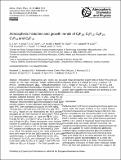| dc.contributor.author | Ivy, Diane J. | |
| dc.contributor.author | Arnold, T. | |
| dc.contributor.author | Harth, C. M. | |
| dc.contributor.author | Steele, L. P. | |
| dc.contributor.author | Muhle, Jens | |
| dc.contributor.author | Rigby, Matthew | |
| dc.contributor.author | Salameh, P. K. | |
| dc.contributor.author | Leist, Michael | |
| dc.contributor.author | Krummel, P. B. | |
| dc.contributor.author | Fraser, P. J. | |
| dc.contributor.author | Weiss, R. F. | |
| dc.contributor.author | Prinn, Ronald G. | |
| dc.date.accessioned | 2012-08-30T20:19:18Z | |
| dc.date.available | 2012-08-30T20:19:18Z | |
| dc.date.issued | 2012-05 | |
| dc.date.submitted | 2012-04 | |
| dc.identifier.issn | 1680-7324 | |
| dc.identifier.issn | 1680-7316 | |
| dc.identifier.uri | http://hdl.handle.net/1721.1/72489 | |
| dc.description.abstract | Atmospheric observations and trends are presented for the high molecular weight perfluorocarbons (PFCs): decafluorobutane (C[subscript 4]F[subscript 10]), dodecafluoropentane (C[subscript 5]F[subscript 12]), tetradecafluorohexane (C[subscript 6]F[subscript 14]), hexadecafluoroheptane (C[subscript 7]F[subscript 16]) and octadecafluorooctane (C[subscript 8]F[subscript 18]). Their atmospheric histories are based on measurements of 36 Northern Hemisphere and 46 Southern Hemisphere archived air samples collected between 1973 to 2011 using the Advanced Global Atmospheric Gases Experiment (AGAGE) "Medusa" preconcentration gas chromatography-mass spectrometry systems. A new calibration scale was prepared for each PFC, with estimated accuracies of 6.8% for C[subscript 4]F[subscript 10], 7.8% for C[subscript 5]F[subscript 12], 4.0% for C[subscript 6]F[subscript 14], 6.6% for C[subscript 7]F[subscript 16] and 7.9% for C[subscript 8]F[subscript 18]. Based on our observations the 2011 globally averaged dry air mole fractions of these heavy PFCs are: 0.17 parts-per-trillion (ppt, i.e., parts per 10[superscript 12]) for C[subscript 4]F[subscript 10], 0.12 ppt for C[subscript 5]F[subscript 12], 0.27 ppt for C[subscript 6]F[subscript 14], 0.12 ppt for C[subscript 7]F[subscript 16] and 0.09 ppt for C[subscript 8]F[subscript 18]. These atmospheric mole fractions combine to contribute to a global average radiative forcing of 0.35 mW m[superscript −2], which is 6% of the total anthropogenic PFC radiative forcing (Montzka and Reimann, 2011; Oram et al., 2012). The growth rates of the heavy perfluorocarbons were largest in the late 1990s peaking at 6.2 parts per quadrillion (ppq, i.e., parts per 10[superscript 15]) per year (yr) for C[subscript 4]F[subscript 10], at 5.0 ppq yr−1 for C[subscript 5]F[subscript 12] and 16.6 ppq yr[superscript −1] for C[subscript 6]F[subscript 14] and in the early 1990s for C7F16 at 4.7 ppq yr−1 and in the mid 1990s for C8F18 at 4.8 ppq yr−1. The 2011 globally averaged mean atmospheric growth rates of these PFCs are subsequently lower at 2.2 ppq yr[superscript −1] for C[subscript 4]F[subscript 10], 1.4 ppq yr[superscript −1] for C[subscript 5]F[subscript 12], 5.0 ppq yr[superscript −1] for C[subscript 6]F[subscript 14], 3.4 ppq yr[superscript −1] for C[subscript 7]F[subscript 16] and 0.9 ppq yr[superscript −1] for C[subscript 8]F[subscript 18]. The more recent slowdown in the growth rates suggests that emissions are declining as compared to the 1980s and 1990s. | en_US |
| dc.description.sponsorship | NASA Upper Atmospheric Research Program (Grant number NNX11AF17G) | en_US |
| dc.language.iso | en_US | |
| dc.publisher | Copernicus GmbH | en_US |
| dc.relation.isversionof | http://dx.doi.org/10.5194/acp-12-4313-2012 | en_US |
| dc.rights | Creative Commons Attribution 3.0 | en_US |
| dc.rights.uri | http://creativecommons.org/licenses/by/3.0/ | en_US |
| dc.source | Copernicus | en_US |
| dc.title | Atmospheric histories and growth trends of C[subscript 4]F[subscript 10], C[subscript 5]F[subscript 12], C[subscript 6]F[subscript 14], C[subscript 7]F[subscript 16] and C[subscript 8]F[subscript 18] | en_US |
| dc.type | Article | en_US |
| dc.identifier.citation | Ivy, D. J. et al. “Atmospheric histories and growth trends of C[subscript 4]F[subscript 10], C[subscript 5]F[subscript 12], C[subscript 6]F[subscript 14], C[subscript 7]F[subscript 16] and C[subscript 8]F[subscript 18].” Atmospheric Chemistry and Physics 12.9 (2012): 4313–4325. | en_US |
| dc.contributor.department | Massachusetts Institute of Technology. Center for Global Change Science | en_US |
| dc.contributor.approver | Prinn, Ronald G. | |
| dc.contributor.mitauthor | Ivy, Diane J. | |
| dc.contributor.mitauthor | Rigby, Matthew | |
| dc.contributor.mitauthor | Prinn, Ronald G. | |
| dc.relation.journal | Atmospheric Chemistry and Physics | en_US |
| dc.eprint.version | Final published version | en_US |
| dc.type.uri | http://purl.org/eprint/type/JournalArticle | en_US |
| eprint.status | http://purl.org/eprint/status/PeerReviewed | en_US |
| dspace.orderedauthors | Ivy, D. J.; Arnold, T.; Harth, C. M.; Steele, L. P.; Mühle, J.; Rigby, M.; Salameh, P. K.; Leist, M.; Krummel, P. B.; Fraser, P. J.; Weiss, R. F.; Prinn, R. G. | en |
| dc.identifier.orcid | https://orcid.org/0000-0001-5925-3801 | |
| mit.license | PUBLISHER_CC | en_US |
| mit.metadata.status | Complete | |
